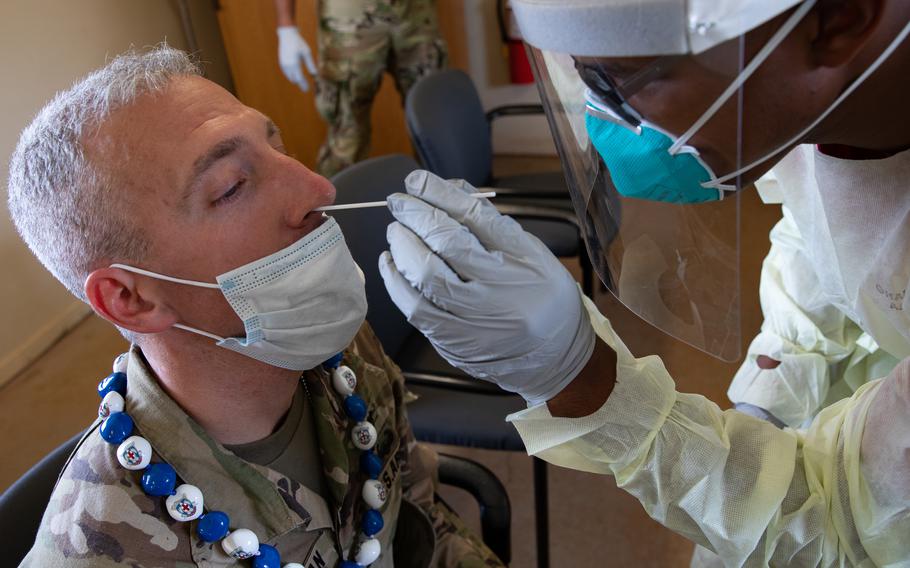
A soldier at Schofield Barracks, Hawaii, is tested for COVID-19 during in-processing for the 2021 U.S. Army Medical Command Best Leader Competition on July 24, 2021. (Antonio Lewis/U.S. Army)
Stars and Stripes is making stories on the coronavirus pandemic available free of charge. See more stories here. Sign up for our daily coronavirus newsletter here. Please support our journalism with a subscription.
FORT SHAFTER, Hawaii — The Army in Hawaii again requires anyone entering its installations to physically hand their ID card to gate guards for authentication, a change in procedure that has struck some as unwise as the state undergoes a dramatic uptick in coronavirus cases.
A hands-off procedure — whereby visitors displayed but held onto their ID cards — was implemented when the pandemic struck in March 2020 over concerns that the coronavirus could be spread by gate guards handling hundreds of ID cards each morning.
The new procedure took effect Monday, a day after Army Garrison Hawaii announced the change on its Facebook page, where it was greeted by some with skepticism.
“I’m sorry, but this is absolutely ridiculous,” wrote commenter Courtney Michelle Edens on Monday. “Lacking any and all common sense. Are we trying to spread covid further? That’s all this is promoting. Also, you can scan and see my card without putting your hands on it after touching God know how many other peoples ID cards.”
Through most of the pandemic, visitors arriving at Fort Shafter, Schofield Barracks and Wheeler Army Airfield have routinely held their ID cards at arm’s length through an opened window, with guards sometimes asking them to flip the cards over to view both sides.
Gate guards at Fort Shafter this week gripped visitors’ Common Access Cards while wearing latex gloves, scanned the bar codes and handed them back.
“There have been some incidents at various gates requiring the return to physically handling of cards, despite the pandemic,” Army Garrison Hawaii spokesman Michael Donnelly told Stars and Stripes in an email Wednesday. He said he could not discuss specific incidents due to operational security reasons.
“With the pivot back to the original standard, our guards all wear protective gloves, and sanitize frequently in a shift to do everything possible to remain COVID-19 compliant and ensure the safety and health of those entering the installations,” Donnelly said.
COVID-19 is the respiratory disease caused by the coronavirus, which is mainly spread when an infected person expels small liquid particles into the air when coughing, sneezing, talking, singing or breathing, according to the World Health Organization. “People may also become infected when touching their eyes, nose or mouth after touching surfaces or objects that have been contaminated by the virus,” according to a factsheet on WHO’s website.
Like most U.S. states, Hawaii has seen a dramatic increase in coronavirus cases due to the highly transmittable omicron variant. As of Wednesday, the state had 45,328 new infections over the previous 14 days.
About 75% of Hawaii’s population is fully vaccinated.